

High-Impact Educational Practices. A Brief Overview Excerpt from High-Impact Educational Practices: What They Are, Who Has Access to Them, and Why They Matter, by George D.
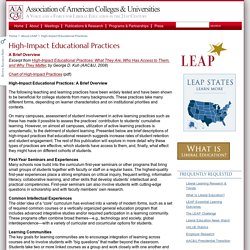
Kuh (AAC&U, 2008) Chart of High-Impact Practices (pdf) High-Impact Educational Practices: A Brief Overview The following teaching and learning practices have been widely tested and have been shown to be beneficial for college students from many backgrounds. On many campuses, assessment of student involvement in active learning practices such as these has made it possible to assess the practices’ contribution to students’ cumulative learning. First-Year Seminars and Experiences Many schools now build into the curriculum first-year seminars or other programs that bring small groups of students together with faculty or staff on a regular basis.
Learning Communities The key goals for learning communities are to encourage integration of learning across courses and to involve students with “big questions” that matter beyond the classroom. Digital Engagement: Driving Student Success. Discrete Program Design and Management Early research emphasizing the student’s role in attrition has influenced the tactical approach to improve student success.
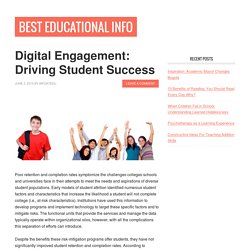
In both the 2004 and 2010 ACT reports “What Works in Student Retention?” Survey respondents overwhelmingly specified student factors over institutional factors when asked to identify the underlying causes of student attrition.17 Institutions agreed that student factors such as unpreparedness, low income, first-generation status, and poor social integration play the most significant roles in student attrition. Institutions have developed targeted programs to address attrition based on these factors. Limited Coordination and Communication about Retention In decentralized environments fragmentation of effort occurs more frequently in the absence of a plan to coordinate and communicate about ways to address retention issues.
Pervasive Data Silos Where Fragmented Approaches Lead The consequences of this fragmented approach follow. Notes. Answering questions about library impact on student learning. This essay reports on a project which evaluated the Understanding Library Impacts (ULI) protocol, a suite of instruments for detecting and communicating library impact on student learning.
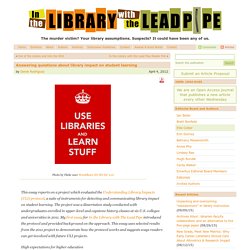
The project was a dissertation study conducted with undergraduates enrolled in upper-level and capstone history classes at six U.S. colleges and universities in 2011. My first essay for In the Library with The Lead Pipe introduced the protocol and provided background on the approach. This essay uses selected results from the 2011 project to demonstrate how the protocol works and suggests ways readers can get involved with future ULI projects. High expectations for higher education These are trying times in U.S. higher education.
Support for teaching and learning is at the heart of most academic library mission statements. Just what outcomes do libraries influence? In my opinion, doing nothing is not an option. The ULI protocol is designed to meet this challenge. K_Crowe_Libraries_2015.pdf. Malenfant-kara-2014. $ Collaborating for Student Success: Libraries and High Impact Educational Practices (ACRL) - Learning Opportunities for Library Staff - State Library of NC. Library Instruction and Academic Success: A Mixed-Methods Assessment of a Library Instruction Program. Library Instruction and Academic Success: A Mixed-Methods Assessment of a Library Instruction Program Abstract Abstract Objectives – This study examines the connection between student academic success and information literacy instruction.
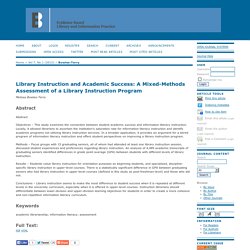
Locally, it allowed librarians to ascertain the institution’s saturation rate for information literacy instruction and identify academic programs not utilizing library instruction services. In a broader application, it provides an argument for a tiered program of information literacy instruction and offers student perspectives on improving a library instruction program. Methods – Focus groups with 15 graduating seniors, all of whom had attended at least one library instruction session, discussed student experiences and preferences regarding library instruction. Librarians on Library Role in Recruitment & Retention. Untitled. + Author Affiliations This study examines the nature and value of undergraduate students’ experiences with the academic library.
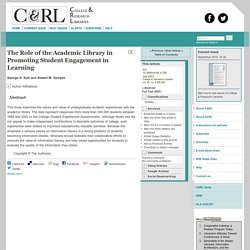
The data represent responses from more than 300,000 students between 1984 and 2002 to the College Student Experiences Questionnaire. Although library use did not appear to make independent contributions to desirable outcomes of college, such experiences were related to important educationally valuable activities. Because the emphasis a campus places on information literacy is a strong predictor of students becoming information literate, librarians should redouble their collaborative efforts to promote the value of information literacy and help create opportunities for students to evaluate the quality of the information they obtain.
Copyright © The Author(s) Academic Libraries and High-Impact Practices for Student Retention: Library Deans’ Perspectives. High-Impact Practices.